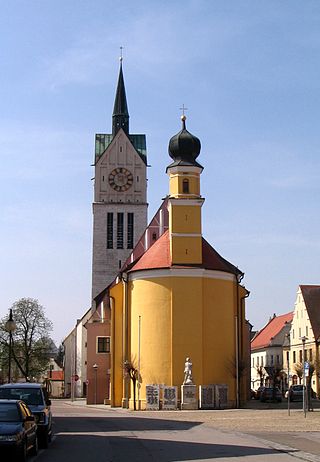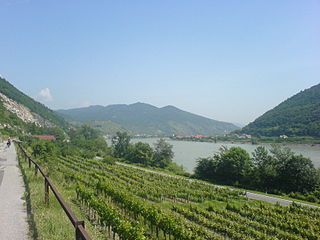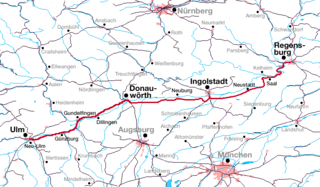
Lower Austria is one of the nine states of Austria, located in the northeastern corner of the country. Since 1986, the capital of Lower Austria has been Sankt Pölten, replacing Vienna, which became a separate state in 1921. With a land area of 19,186 km2 (7,408 sq mi) and a population of 1.685 million people, Lower Austria is the second-most-populous state in Austria. Other large cities are Amstetten, Klosterneuburg, Krems an der Donau, Stockerau and Wiener Neustadt.
The Ostalbkreis is a Landkreis (district) in the east of Baden-Württemberg, Germany, on the border to Bavaria. Neighboring districts are Schwäbisch Hall, Ansbach, Donau-Ries, Heidenheim, Göppingen and Rems-Murr.
Dillingen is a Landkreis (district) in Swabia, Bavaria, Germany. It is bounded by the districts of Donau-Ries, Augsburg and Günzburg, and by the state of Baden-Württemberg.
Eichstätt is a Landkreis (district) in Bavaria, Germany. It is bounded by the districts of Neuburg-Schrobenhausen, Donau-Ries, Weißenburg-Gunzenhausen, Roth, Neumarkt, Kelheim and Pfaffenhofen, and by the city of Ingolstadt.

The Hallertau or Holledau is an area in Bavaria, Germany. With an area of 178 km2, it is listed as the largest continuous hop-planting area in the world. According to the International Hop Growing Convention, Germany produces roughly one third of the world's hops, over 80% of which are grown in the Hallertau.

The Rhine–Main–Danube Canal, is a canal in Bavaria, Germany. Connecting the Main and the Danube rivers across the European Watershed, it runs from Bamberg via Nuremberg to Kelheim. The canal connects the North Sea and Atlantic Ocean to the Black Sea, providing a navigable artery between the Rhine delta, and the Danube Delta in south-eastern Romania and south-western Ukraine. The present canal was completed in 1992 and is 171 kilometres (106 mi) long.

G. Schneider & Sohn is a weissbier brewing company in Bavaria, Germany.

Neustadt an der Donau is a town in Lower Bavaria on the Danube in Bavaria, Germany. Lying on the western border of Landkreis Kelheim, Neustadt is primarily known for the thermal spa Bad Gögging. Neustadt had a population of 12,753 as of December 31, 2003.

Riedenburg is a town in the district of Kelheim, in Bavaria, Germany. It is situated on the river Altmühl, 16 km (10 mi) northwest of Kelheim and 29 km (18 mi) northeast of Ingolstadt. Prunn Castle is located in Riedenburg.

Neustadt am Main is a community in the Main-Spessart district in the Regierungsbezirk of Lower Franconia (Unterfranken) in Bavaria, Germany and a member of the Verwaltungsgemeinschaft Lohr am Main.
Hachez was a chocolate manufacturing company based in Bremen in northern Germany. It was founded in 1890 by Joseph Emile Hachez and Gustav Linde. The Feodora pralines and chocolate brand has been part of the company since 1953. In 2012, the Danish confectionery company Toms took over the company, which is now run under the name Hanseatisches Chocoladen Kontor. Production has been taking place in Nowa Sól in Poland since 2020.

Setzingen is a village in the district of Alb-Donau in Baden-Württemberg in Germany.

EuroVelo 6 (EV6), named the "Rivers Route", is a EuroVelo long-distance cycling route that runs along 3,653 km (2,270 mi) some of Europe's major rivers, including much of the Loire, some of the Saône, a short section of the upper Rhine and almost the entire length of Europe’s second longest river, the Danube — from the Atlantic coast of France to the city of Constanța on the Black Sea.
The 1999 Pentecost flood was a 100-year flood around the Pentecost season in 1999 that mostly affected Bavaria, Vorarlberg and Tirol. It was caused by heavy rainfall coinciding with the regular Alpine meltwater.

The Regensburg–Ingolstadt railway is a single-track, electrified mainline railway in Bavaria, Germany. It runs in the Danube valley from Regensburg to Ingolstadt. The Regensburg–Ingolstadt railway and the Ingolstadt–Neuoffingen railway together form the Bavarian Danube Valley Railway (Donautalbahn).

Rottenegg is a village in the Hallertau of Bavaria, Germany. Formerly a separate municipality, it is now part of the municipality of Geisenfeld in the Upper Bavarian district of Pfaffenhofen.

The Neustadt is a district of Strasbourg, Bas-Rhin, France. In 2017, the heart of the district was listed as a World Heritage Site by UNESCO, as an extension of the site including the older city centre and Strasbourg Cathedral. The district is a unique example of city planning, merging the Haussmannian model with elements of German architecture and urban planning.

Wöhr is an historic town, and now district of Neustadt an der Donau in Lower Bavaria on the Danube in Bavaria, Germany.

Hienheim is a district of the town of Neustadt an der Donau in the district of Kelheim in Bavaria, Germany.

The Verkehrsverbund Großraum Nürnberg is the transit authority of the city of Nuremberg, the second largest city of the German state of Bavaria. Its jurisdiction covers the city and its surrounding area, responsible for the Nuremberg S-Bahn commuter trains, the Nuremberg U-Bahn, the Nuremberg tramway and buses. While not co-extensive with the wider Nuremberg Metropolitan Region, it covers most of it with the exception of several smaller towns and rural areas on the periphery, as well as Sonneberg in the neighboring state of Thuringia.
















